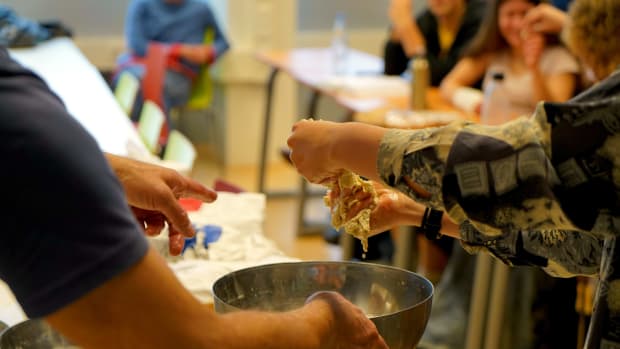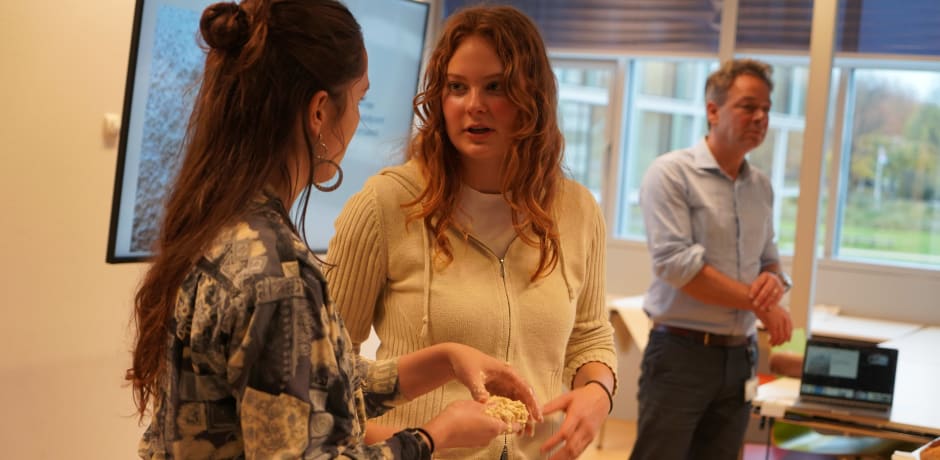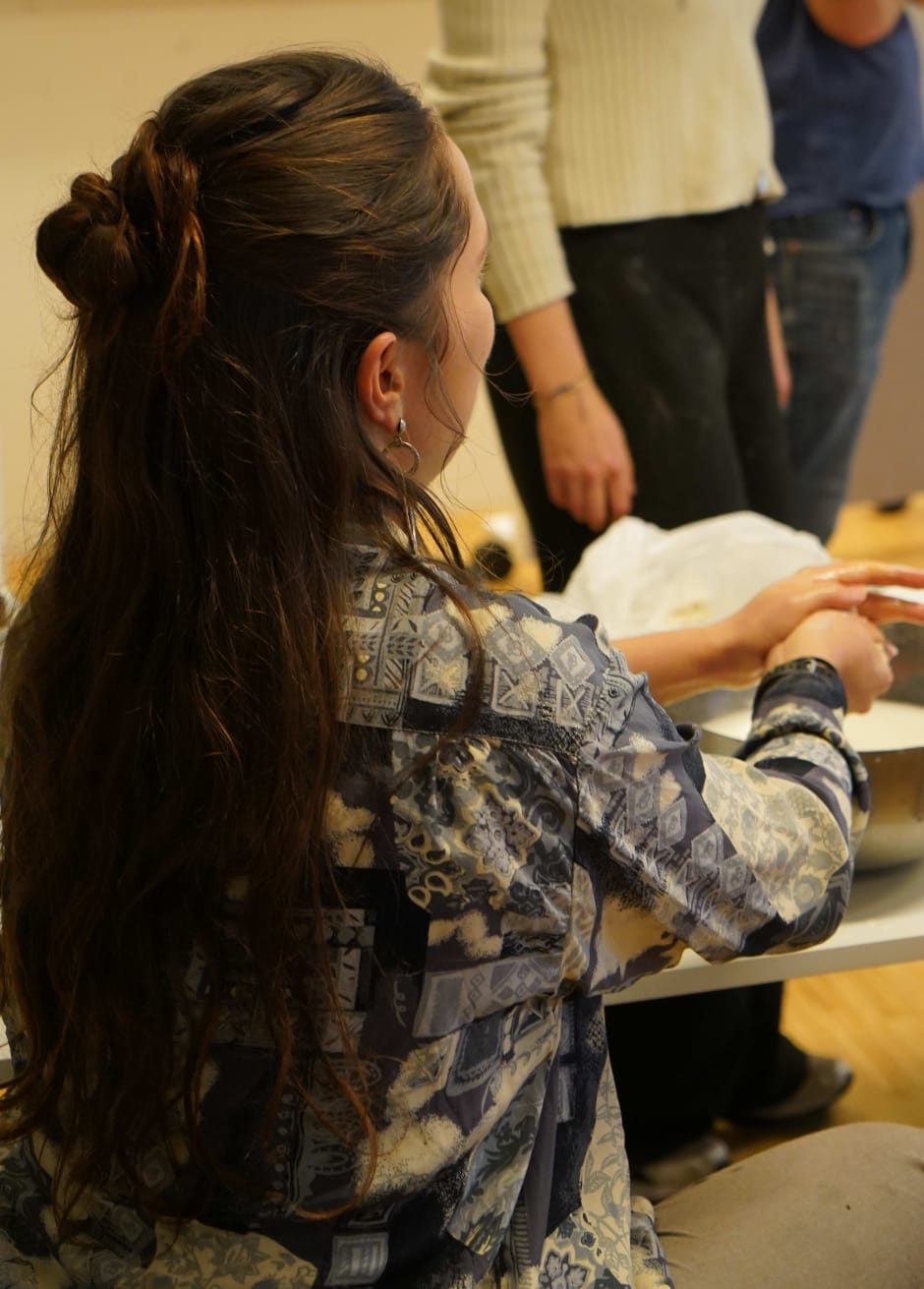
Students make bread during lecture: full classroom in course on science behind cooking
Chemistry and physics are inextricably linked to cooking and baking. This is evident from the UvA course Culinary Science, where scientists join forces with bakers and chefs. Students learn that a chemical reaction causes air bubbles and the rising of bread, making it deliciously light and airy.
“Flour and water are the basic ingredients of bread dough,” says physics professor Daniël Bonn to the students at the start of his lecture on bread making. He then explains how remarkable it is that molecules in dough “hold on to each other,” allowing you to knead dough into all kinds of shapes. The forty students attending the course Culinary ScienceCulinary science is the science behind how cooking techniques and ingredients influence the taste, texture, and quality of food. learn about the physical and chemical processes behind bread making during this lecture, while at the same time getting their hands dirty by actually kneading dough.
During the theoretical explanation, sourdough bread, rye bread, Iranian flatbread, French bâtard bread, dough mixtures prepared in different ways, and different types of salt are passed around the classroom. And it doesn’t stop at touching the ingredients; students smell and taste the different components of bread.
The lecture is not only given by physicist Bonn. Bonn’s explanations of bread making are interspersed with the practical experience of two bakers, Jechiam Gural and Janine Kers, from Baking Lab. This lecture was created together with Baking Lab, which is a bakery and laboratory, where scientific knowledge and sustainable principles are used to experiment with bread baking. Baker Kers is a UvA mathematics alumnus and says: “At Baking Lab, I can put exact theories into practice, such as mathematical differential equations that can be used to calculate the rising of bread. It is the perfect combination of precise thinking and working with your hands.”
The sourdough starter
At the beginning of the lecture, the bakers pass around a sourdough starter. A sourdough starter is a mixture of flour and water in which, after some time, certain yeasts develop that can be used to bake sourdough bread. “In the bakery, we use a sourdough starter that is already eight years old,” says Kers. The students become enthusiastic and smell the vinegary scent of the mixture, and some dip their pinky finger into the container to taste it.
The students eagerly begin asking the bakers questions: “How much water and flour do you need to mix for this starter? How long do you have to wait for a good amount of yeast to develop?” But Bonn realizes that his lecture will not finish on time if he continues like this: “I’m the physicist, so let’s talk about physics now.” Bonn follows this remark with an explanation of the chemical fermentation process in bread dough. He explains how bread rises through a chemical process; a reaction between yeast and flour releases carbon dioxide, among other things, which forms air bubbles in the bread and causes it to rise.

Cooking makes science palatable
Course coordinators and initiators of this course Antoine Deblais and Ioana Ilie explain how each lecture is a collaboration between a scientist and artisans specializing in the type of food covered in that lesson. “Culinary science is a great opportunity to attract students to the exact sciences,” says Ilie. “Your whole life revolves around food, and there’s a lot of science behind cooking, which is why cooking or baking is a good platform for sparking curiosity about physics and chemistry,” says Deblais.
A physical process that takes place when making bread is the viscoelasticity of the dough, Bonn explains. Viscoelasticity is the behavior of a substance that acts like a liquid and is also elastic, meaning it can be deformed. Bonn throws a bouncy ball made of blue putty, which you can find in toy stores, and shows that when you put it down, the ball slowly spreads out like a liquid, just like dough.

Motivated students
As soon as the bakers need a volunteer to knead dough, master’s student in analytical chemistry Loïs Hana is happy to help. She rolls up her sleeves and starts kneading the seemingly indefinable and lumpy mixture with her hands. Kers demonstrates the best way to knead and says, “You have to think of kneading bread like training a muscle at the gym; it also needs rest, and you shouldn’t knead too much.”
Physics student Elena Fritz loves cooking and baking, which is why she chose this course. As a final assignment, students have to cook something and then give a presentation on the science behind their dish. Fritz and a fellow student are making the Portuguese egg tart Pastel de Nata. “It’s really cool to see physics applied to cooking. For example, we learned about the behavior of granulars, which has changed the way I look at sugar.” In his lecture, Bonn points out that when you stir a spoon in a bowl of sugar, which is granular, only the first few layers around the spoon move, while the rest remains still.
In between the scientific theory - the nice scent in a bakery comes from the alcohol that is released during the fermentation process - the students continue to ask the bakers lots of questions. During the break, a group of about ten students gather around the two bakers and ask for tips on how to bake bread at home. Bakers Kers and Gural: “Maybe you should knead more slowly. Maybe it’s your oven. Try adding the salt at the end of the kneading process.” The students are eager to bake the best bread at home.
Course coordinators Deblais and Ilie also see that the students are very enthusiastic about the course and that almost the entire group always attends the lectures. Currently, Culinary Science is only accessible to honors students. But Deblais sees a lot of enthusiasm: “Even colleagues are attending the lectures.” That is why Deblais and Ilie are putting in effort to make the course widely accessible to all students next year.
At the end of the lecture, Bonn cuts the loaf of bread that has been sitting at the front of the classroom throughout the lesson and hands out slices. It is a rye sourdough bread. One student says after the lesson: “I’m going to ask if there’s any bread left because I’d like to have another slice.”


